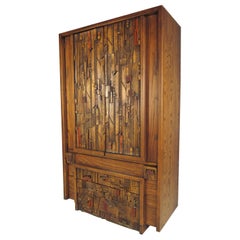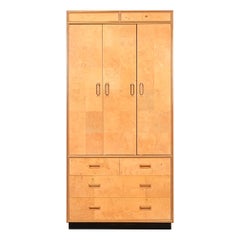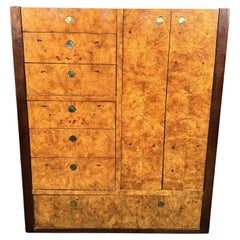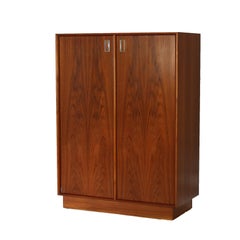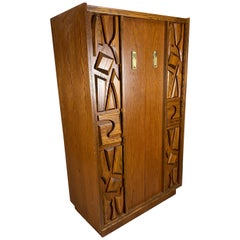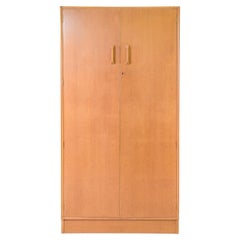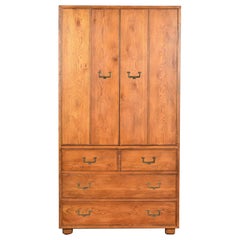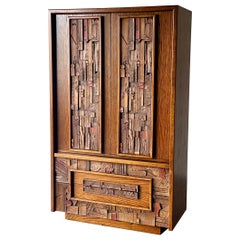Mid Century Modern Armoire
Mid-20th Century American Mid-Century Modern Wardrobes and Armoires
Walnut
Vintage 1980s American Mid-Century Modern Linen Presses
Ash, Ebony, Burl
Mid-20th Century Unknown Mid-Century Modern Wardrobes and Armoires
Wood
Mid-20th Century Mid-Century Modern Wardrobes and Armoires
Teak
Vintage 1960s Canadian Mid-Century Modern Wardrobes and Armoires
Brass
Vintage 1960s Danish Scandinavian Modern Wardrobes and Armoires
Teak
Vintage 1970s Danish Mid-Century Modern Wardrobes and Armoires
Teak
Vintage 1970s American Mid-Century Modern Wardrobes and Armoires
Brass
Vintage 1970s American Mid-Century Modern Wardrobes and Armoires
Walnut
Mid-20th Century British Mid-Century Modern Wardrobes and Armoires
Teak
Mid-20th Century British Mid-Century Modern Wardrobes and Armoires
Teak
Vintage 1960s English Mid-Century Modern Wardrobes and Armoires
Teak
Mid-20th Century British Mid-Century Modern Wardrobes and Armoires
Teak
Vintage 1960s Danish Scandinavian Modern Wardrobes and Armoires
Teak
Vintage 1970s Danish Mid-Century Modern Wardrobes and Armoires
Rosewood
Mid-20th Century Unknown Mid-Century Modern Wardrobes and Armoires
Wood
Vintage 1970s American Mid-Century Modern Wardrobes and Armoires
Walnut
Vintage 1970s American Mid-Century Modern Wardrobes and Armoires
Walnut
Vintage 1970s Danish Mid-Century Modern Wardrobes and Armoires
Teak
Vintage 1970s American Mid-Century Modern Wardrobes and Armoires
Wood
Vintage 1970s American Mid-Century Modern Wardrobes and Armoires
Walnut
Vintage 1940s French Directoire Wardrobes and Armoires
Wood
Vintage 1970s American Mid-Century Modern Wardrobes and Armoires
Wood
Vintage 1970s American Mid-Century Modern Wardrobes and Armoires
Walnut
Vintage 1970s American Mid-Century Modern Wardrobes and Armoires
Oak, Mirror
Vintage 1970s Canadian Mid-Century Modern Wardrobes and Armoires
Chrome
Vintage 1970s American Mid-Century Modern Wardrobes and Armoires
Wood
Vintage 1970s American Mid-Century Modern Wardrobes and Armoires
Wood
Mid-20th Century American Mid-Century Modern Wardrobes and Armoires
Aluminum
Vintage 1970s American Mid-Century Modern Wardrobes and Armoires
Mahogany, Rosewood
Mid-20th Century Belgian Mid-Century Modern Wardrobes and Armoires
Palmwood
Vintage 1960s Mid-Century Modern Wardrobes and Armoires
Walnut
Mid-20th Century American Mid-Century Modern Wardrobes and Armoires
Metal, Chrome
Vintage 1970s American Mid-Century Modern Wardrobes and Armoires
Walnut
Vintage 1950s American Mid-Century Modern Wardrobes and Armoires
Brass
Vintage 1970s American Mid-Century Modern Wardrobes and Armoires
Burl, Lacquer
Mid-20th Century Brazilian Mid-Century Modern Wardrobes and Armoires
Hardwood
Mid-20th Century Italian Mid-Century Modern Wardrobes and Armoires
Wood
Antique 1870s Mid-Century Modern Wardrobes and Armoires
Chrome
Mid-20th Century American Modern Wardrobes and Armoires
Mirror, Wood
Vintage 1950s Italian Mid-Century Modern Wardrobes and Armoires
Bronze
Vintage 1960s Mid-Century Modern Wardrobes and Armoires
Brass
Late 20th Century French Mid-Century Modern Wardrobes and Armoires
Glass, Wood, Oak
Mid-20th Century Italian Mid-Century Modern Wardrobes and Armoires
Wicker, Rattan, Wood
Vintage 1960s Danish Mid-Century Modern Wardrobes and Armoires
Teak
Vintage 1960s Italian Scandinavian Modern Wardrobes and Armoires
Beech
Mid-20th Century English Mid-Century Modern Wardrobes and Armoires
Teak
Mid-20th Century French Mid-Century Modern Wardrobes and Armoires
Oak
Mid-20th Century French Mid-Century Modern Wardrobes and Armoires
Oak
Vintage 1950s Italian Wardrobes and Armoires
Brass
Vintage 1960s Danish Scandinavian Modern Wardrobes and Armoires
Teak
Mid-20th Century German Mid-Century Modern Wardrobes and Armoires
Teak
Vintage 1960s Austrian Mid-Century Modern Wardrobes and Armoires
Brass
Vintage 1970s American Mid-Century Modern Wardrobes and Armoires
Oak
Vintage 1970s Danish Mid-Century Modern Wardrobes and Armoires
Birch, Rosewood
Vintage 1960s Austrian Mid-Century Modern Wardrobes and Armoires
Brass
Vintage 1970s Italian Mid-Century Modern Wardrobes and Armoires
Brass
Vintage 1950s Austrian Mid-Century Modern Wardrobes and Armoires
Brass
Vintage 1970s American Mid-Century Modern Wardrobes and Armoires
Chrome
Vintage 1940s French Mid-Century Modern Wardrobes and Armoires
Oak
- 1
- ...
Mid Century Modern Armoire For Sale on 1stDibs
How Much is a Mid Century Modern Armoire?
A Close Look at Mid-century Modern Furniture
Organically shaped, clean-lined and elegantly simple are three terms that well describe vintage mid-century modern furniture. The style, which emerged primarily in the years following World War II, is characterized by pieces that were conceived and made in an energetic, optimistic spirit by creators who believed that good design was an essential part of good living.
ORIGINS OF MID-CENTURY MODERN FURNITURE DESIGN
- Emerged during the mid-20th century
- Informed by European modernism, Bauhaus, International style, Scandinavian modernism and Frank Lloyd Wright’s architecture
- A heyday of innovation in postwar America
- Experimentation with new ideas, new materials and new forms flourished in Scandinavia, Italy, the former Czechoslovakia and elsewhere in Europe
CHARACTERISTICS OF MID-CENTURY MODERN FURNITURE DESIGN
- Simplicity, organic forms, clean lines
- A blend of neutral and bold Pop art colors
- Use of natural and man-made materials — alluring woods such as teak, rosewood and oak; steel, fiberglass and molded plywood
- Light-filled spaces with colorful upholstery
- Glass walls and an emphasis on the outdoors
- Promotion of functionality
MID-CENTURY MODERN FURNITURE DESIGNERS TO KNOW
- Charles and Ray Eames
- Eero Saarinen
- Milo Baughman
- Florence Knoll
- Harry Bertoia
- Isamu Noguchi
- George Nelson
- Danish modernists Hans Wegner and Arne Jacobsen, whose emphasis on natural materials and craftsmanship influenced American designers and vice versa
ICONIC MID-CENTURY MODERN FURNITURE DESIGNS
- Eames lounge chair
- Nelson daybed
- Florence Knoll sofa
- Egg chair
- Womb chair
- Noguchi coffee table
- Barcelona chair
VINTAGE MID-CENTURY MODERN FURNITURE ON 1STDIBS
The mid-century modern era saw leagues of postwar American architects and designers animated by new ideas and new technology. The lean, functionalist International-style architecture of Le Corbusier and Bauhaus eminences Ludwig Mies van der Rohe and Walter Gropius had been promoted in the United States during the 1930s by Philip Johnson and others. New building techniques, such as “post-and-beam” construction, allowed the International-style schemes to be realized on a small scale in open-plan houses with long walls of glass.
Materials developed for wartime use became available for domestic goods and were incorporated into mid-century modern furniture designs. Charles and Ray Eames and Eero Saarinen, who had experimented extensively with molded plywood, eagerly embraced fiberglass for pieces such as the La Chaise and the Womb chair, respectively.
Architect, writer and designer George Nelson created with his team shades for the Bubble lamp using a new translucent polymer skin and, as design director at Herman Miller, recruited the Eameses, Alexander Girard and others for projects at the legendary Michigan furniture manufacturer.
Harry Bertoia and Isamu Noguchi devised chairs and tables built of wire mesh and wire struts. Materials were repurposed too: The Danish-born designer Jens Risom created a line of chairs using surplus parachute straps for webbed seats and backrests.
The Risom lounge chair was among the first pieces of furniture commissioned and produced by celebrated manufacturer Knoll, a chief influencer in the rise of modern design in the United States, thanks to the work of Florence Knoll, the pioneering architect and designer who made the firm a leader in its field. The seating that Knoll created for office spaces — as well as pieces designed by Florence initially for commercial clients — soon became desirable for the home.
As the demand for casual, uncluttered furnishings grew, more mid-century furniture designers caught the spirit.
Classically oriented creators such as Edward Wormley, house designer for Dunbar Inc., offered such pieces as the sinuous Listen to Me chaise; the British expatriate T.H. Robsjohn-Gibbings switched gears, creating items such as the tiered, biomorphic Mesa table. There were Young Turks such as Paul McCobb, who designed holistic groups of sleek, blond wood furniture, and Milo Baughman, who espoused a West Coast aesthetic in minimalist teak dining tables and lushly upholstered chairs and sofas with angular steel frames.
Generations turn over, and mid-century modern remains arguably the most popular style going. As the collection of vintage mid-century modern chairs, dressers, coffee tables and other furniture for the living room, dining room, bedroom and elsewhere on 1stDibs demonstrates, this period saw one of the most delightful and dramatic flowerings of creativity in design history.
Finding the Right Wardrobes-armoires for You
When shopping for antique and vintage wardrobes and armoires for your home, there are several things to keep in mind, not least of which is question number 1:
What is the difference between an armoire and a wardrobe?
The difference between an armoire and a wardrobe is actually simple: An armoire is merely an ornate wardrobe. A wardrobe is a tall, streamlined storage cabinet that usually has some combination of drawers, shelves and hanging rods.
Antique and vintage armoires, on the other hand, are freestanding, heavy wooden structures that typically feature decorative metal hinges and pictorial carvings. Armoires are large cabinets that aren’t outfitted with the varied storage features that wardrobes now commonly have. Armoires often have one or two doors and a hanging bar and allow for quick access. Whether a minimalist mid-century modern wardrobe or grandiose Victorian-era armoire is the right fit for you, both are highly functional furnishings and can be a smart storage solution.
Armoires have been around since medieval times, and initially they may have housed weapons and armor. In their early days, armoires were often adorned with elaborate carvings and lavish paintings, particularly in Renaissance-era France. During the 18th century and later, armoires were widely known as “presses” for hanging clothes, and they were so large that they swallowed up the room where they stood.
In today’s modern homes, an antique armoire can be a striking, architectural work of art amid comparably unadorned furnishings. Whether you’re using your piece in the kitchen for cookware or as a food pantry, in the bedroom for clothes or in the living room as a media console, it will likely become a lovable focal point.
The evolution of the armoire can be seen in today’s corner wardrobes, which may rest on an asymmetrical base to account for corner placement, and even mirrored wardrobes, which feature a mirror affixed to the inside panel of one of the doors for convenience. Contemporary wardrobes commonly feature additional sliding trays and drawers and hanging space for clothing or linens, and the cabinet doors make them ideal for concealing televisions and computer monitors when such devices aren’t in use.
When choosing the right wardrobe or vintage armoire for your home, it’s good to have the following in mind: What are you planning to store in it? How much of what you’re storing will need to be housed in it? It should be big enough to accommodate your needs. What is the size of the room where your wardrobe or armoire will live? A large new piece of furniture in a modest space can easily become a hindrance if you have to navigate your way around it during your daily routine, so be mindful of the area you'll need in order to move freely.
Whether you are looking for an antique walnut armoire or a simple contemporary wardrobe, find the right piece for your home today on 1stDibs.
- 1stDibs ExpertFebruary 27, 2024The difference between mid-century and mid-century modern comes down to specificity. When it comes to furniture and architecture, for example, mid-century refers to works that emerged during the middle of the 20th century, usually between 1950 and 1970. The more specific descriptor, mid-century modern, is used to refer to a particular style of design that emphasizes simplicity, organic forms and clean lines. Mid-century modern furniture designers generally drew on the architectural work of Frank Lloyd Wright, Bauhaus design, Scandinavian modernism and more. Any piece of furniture produced during the 1950s and ’60s can be referred to as mid-century, but only those with specific characteristics are mid-century modern. That said, when enthusiasts of furniture and architecture use the shorter of the two phrases, they may indeed be referring to modernist works created during that period in history. On 1stDibs, find a wide variety of mid-century modern furniture.
- Is Eames mid-century modern?1 Answer1stDibs ExpertFebruary 13, 2024Yes, Eames is mid-century modern. In many ways, Charles Eames and Ray Eames were the embodiment of the inventiveness, energy and optimism at the heart of mid-century modern American design, and they have been recognized as the most influential designers of the 20th century. Some of the couple's most famous mid-century modern designs include the Eames Lounge chair and ottoman, the Eames Molded Plywood chair and the Eames Fiberglass chair. Shop a wide range of Charles and Ray Eames furniture on 1stDibs.
- 1stDibs ExpertMay 22, 2019
Mid-century modernism first appeared in 1945 and merged a minimalist aesthetic with practicality. Mid-century modern furniture is distinguishable by its lack of decoration or extravagance and its use of clean lines, organic curves and variety of natural materials.
1stDibs ExpertFebruary 22, 2021Mid century modern furniture refers to pieces designed during the middle of the 20th century — specifically 1930s through the mid-1960s. This period represents a design and architecture movement characterized by simple shapes, clean lines, and organic materials. Some of the most famous mid century modern designers include Ray Eames, Charlotte Perriand, Isamu Noguchi and Eero Saarinen. - 1stDibs ExpertFebruary 22, 2021Mid century modern refers to the middle of the 20th century — specifically 1930s through the mid-1960s. This period represents a design and architecture movement characterized by simple shapes, clean lines, and organic materials. Some of the most famous mid century modern designers include Ray Eames, Charlotte Perriand, Isamu Noguchi and Eero Saarinen.
- 1stDibs ExpertApril 25, 2024The years that encompass the mid-century modern period are roughly 1933 until 1965, but most experts argue, however, that the mid-century modern era correlates specifically to the years following World War II. These years in America saw one of the most delightful and dramatic flowerings of creativity in design history. Vintage mid-century modern furniture — including tables, chairs, desks and case pieces — are often organically shaped, clean-lined and elegantly simple.
Postwar architects and designers in the United States were animated by new ideas and new technology during the era of mid-century modernism. Materials developed for wartime use became available for domestic goods and were incorporated into mid-century furniture designs manufactured by the likes of Knoll and Herman Miller.
Charles and Ray Eames and Eero Saarinen, who had experimented extensively with molded plywood, eagerly embraced fiberglass for pieces such as the La Chaise and the Womb chair, respectively.
Knoll became a chief influencer in the rise of modern design in the United States, thanks to the work of Florence Knoll, the pioneering architect and designer who made the firm a leader in its field. The seating that Knoll created for office spaces soon became desirable for the home. Similarly, Michigan’s Herman Miller is best known for its iconic mid-century modern furniture, and while the company focused on the office, people loved its designs for their homes, too.
Find vintage mid-century modern furniture for sale on 1stDibs. - Is rattan mid-century modern?1 Answer1stDibs ExpertMarch 13, 2024Yes, some rattan is mid-century modern. Designers of the mid-century modern movement often preferred to use natural materials, including rattan, in their designs. However, not all rattan furniture was made during this period. Rattan was also a popular material for furniture produced during the Victorian era and continues to be used to produce furniture today. Shop a wide range of rattan furniture on 1stDibs.
- Is Mondrian mid century modern?1 Answer1stDibs ExpertApril 5, 2022Yes, Mondrian’s art is believed to be one of the great inspirations for the mid-century modern approach to minimalism. His artworks were not just a departure from figurative works, but a new look at abstract art as well. On 1stDibs, find a variety of original artwork from top artists.
- Is mid-century modern timeless?1 Answer1stDibs ExpertApril 22, 2024Yes, mid-century modern is timeless, in the opinion of many experts. Many characteristics of furniture and decorative accents produced in this style remain popular today. Among them are silhouettes marked by organic forms and clean lines, the promotion of functionality and the use of natural materials like teak, rosewood and oak and synthetic materials such as steel, fiberglass and molded plywood. On 1stDibs, shop a large collection of mid-century modern furniture.
- 1stDibs ExpertFebruary 22, 2021Most experts agree that mid-century modern correlates specifically to the years following World War II. It has grown in popularity in the decades since, particularly due to the media and cultural institutions that have promoted the truly innovative era of design. Not only did the MoMA promote modern furniture, but pieces are prominently visible on the set of very popular television shows such as Mad Men. Shop a wide and beautiful range of mid-century modern furniture on 1stDibs.
- 1stDibs ExpertApril 5, 2022Yes, Wassily chairs are indeed considered mid-century modern. Although the chair was initially designed by Marcel Breuer in 1925, it was re-released in the 1960s. Shop a collection of mid-century modern goods from some of the world’s top sellers on 1stDibs.
- Is Art Deco mid-century modern?1 Answer1stDibs ExpertAugust 15, 2019
Art Deco is not mid-century modern. Art Deco began just before World War I and was inspired by cubism. Mid-century modernism first appeared in 1945 and merged a minimalist aesthetic with practicality.
- 1stDibs ExpertApril 5, 2022Yes, the tulip table is considered a mid-century modern design. This table shape has become an iconic statement of the era with a simple sculptural attitude and a practical nature. The first tulip table was created by Eero Saarinen, a noted Finnish designer who was a leader in mid-century modern home decor. Shop a collection of Saarinen furniture from some of the world’s top sellers on 1stDibs.
- 1stDibs ExpertSeptember 25, 2019
Mid-century modern furniture combines sleek lines with organic shapes.
- 1stDibs ExpertApril 5, 2024There is no single color wood that is mid-century modern. Designers working in the style employed a variety of finishes, though purplish reds, mid-yellows, light browns and medium dark browns were among the most commonly used. Teak wood was an especially popular material, not only due to its warm medium hue but also due to its strength and the beauty of its natural grain. Shop a wide range of mid-century modern furniture on 1stDibs.
- 1stDibs ExpertFebruary 13, 2024Mid-century modern furniture is so popular largely because its characteristics align well with the trends and tastes that are dominant today. Many people love its simple look defined by clean lines, and the use of natural materials also adds to its popularity. In addition, designers created mid-century modern furniture to be as functional as it is visually appealing, making pieces executed in the style simple, convenient and comfortable to use. Find a wide range of mid-century modern furniture on 1stDibs.
- 1stDibs ExpertApril 22, 2024There is not a single year that is mid-century modern. The style emerged during the 1940s and 1950s and remained dominant through the 1960s and into the early 1970s. Some notable designers who contributed to the development of the mid-century modern style include Charles and Ray Eames, Eero Saarinen, Milo Baughman, Florence Knoll, Harry Bertoia, Isamu Noguchi and George Nelson. Shop a wide range of mid-century modern furniture on 1stDibs.
- 1stDibs ExpertMarch 3, 2023Some iconic chairs from the mid-century modern era include the Egg chair by Arne Jacobson, the La Chaise by Charles and Ray Eames and the Womb chair by Eero Saarinen. With their clean lines, organic shapes and simple details, these chairs reflect some of the key features of the style. Shop a variety of mid-century modern chairs on 1stDibs.
- 1stDibs ExpertSeptember 25, 2019
Mid-century home decor is characterized by clean lines, geometric shapes and materials like wood and tweed.
- 1stDibs ExpertSeptember 25, 2019
Some of the most famous mid-century modern furniture designers were Alvar Aalto, Charles and Ray Eames, Paul Evans, Poul Kjærholm, Florence Knoll, George Nakashima, Giò Ponti, Hans Wegner, Charlotte Perriand, Sergio Rodrigues and Eero Saarinen.
- 1stDibs ExpertOctober 12, 2021There are many colors available for painting a mid-century modern home and it is a matter of preference. You can choose from a range of colors that are closely associated with mid-century modernism — popular pairings include orange and brown or chartreuse and gray, for example. Find a wide variety of mid-century modern furniture, decorative pieces, serveware and lighting on 1stDibs today.
